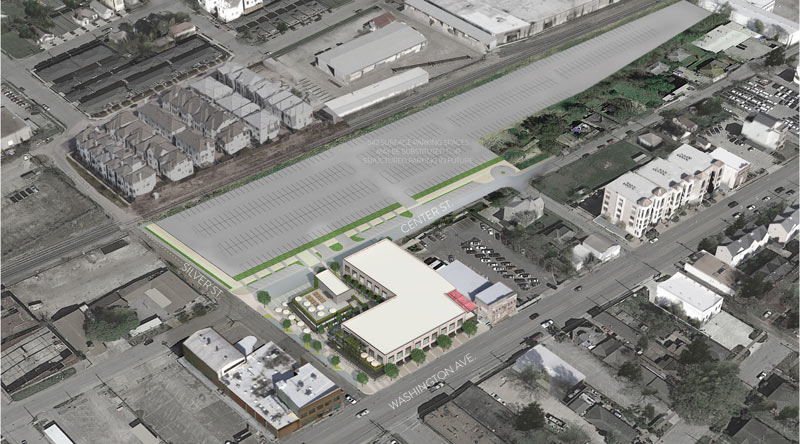
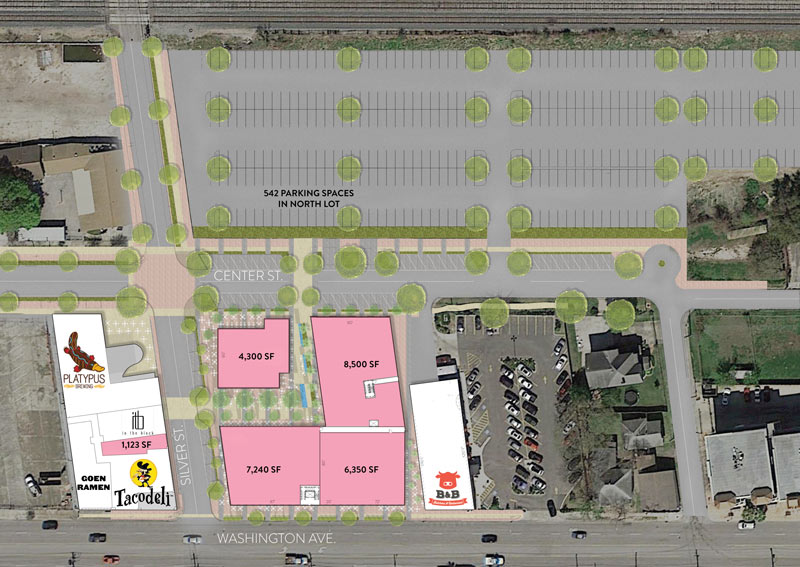
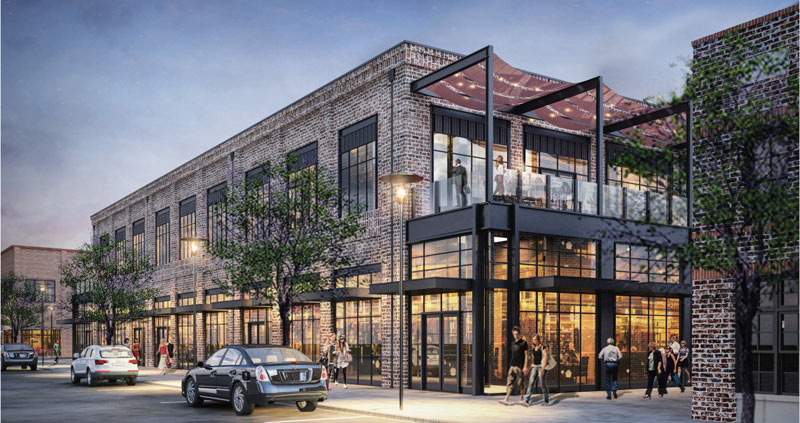 The paved lot now being marketed as 1818 Washington Ave. (across Silver St. from that recently recolonized cluster of ex-nightclub buildings, and bookended to the east by the former bakery now housing B&B Butchers) appears to be marked for some higher purposes, per recently released leasing materials for the property. Plans on Lovett Commercial’s flier for the site show 2 structures (rendered above as things might look from Washington Ave., facing toward Tacodeli) that pretty much fill up the whole piece of land — but fear not, parking-requirement hawks! The land directly north of the property, a 2-block elongated space nestled mostly between Center St. and a stretch of Union Pacific railroad, is marked up to become a 4-plus-acre surface lot, with room for 542 cars or so; that’d likely more than make up for the parking spaces that B&B would lose, too.
The paved lot now being marketed as 1818 Washington Ave. (across Silver St. from that recently recolonized cluster of ex-nightclub buildings, and bookended to the east by the former bakery now housing B&B Butchers) appears to be marked for some higher purposes, per recently released leasing materials for the property. Plans on Lovett Commercial’s flier for the site show 2 structures (rendered above as things might look from Washington Ave., facing toward Tacodeli) that pretty much fill up the whole piece of land — but fear not, parking-requirement hawks! The land directly north of the property, a 2-block elongated space nestled mostly between Center St. and a stretch of Union Pacific railroad, is marked up to become a 4-plus-acre surface lot, with room for 542 cars or so; that’d likely more than make up for the parking spaces that B&B would lose, too.
That’s the apparent plan for now, anyway — the flier does point out that some kind of garage structure is probably on the table for later on. As for the yet-unbuilt spaces for lease: The site plans show an L-shaped 2-story building, plus a smaller, squatter freestanding restaurant space tucked back along the corner of Silver and Center. The larger structure has spots marked off for a couple of upstairs patios, as well as office use:Â
***
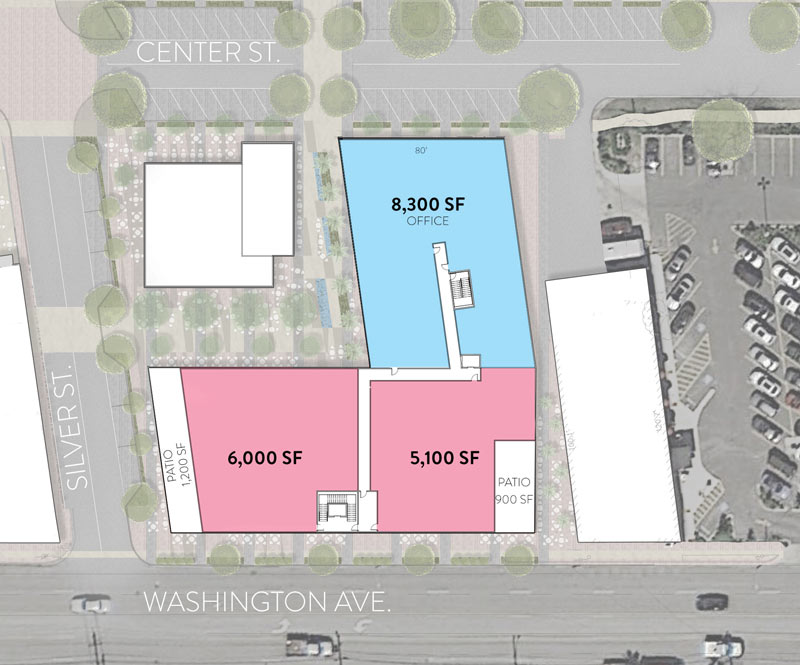
Here’s the rendered view looking east-ish across Silver St., toward B&B:
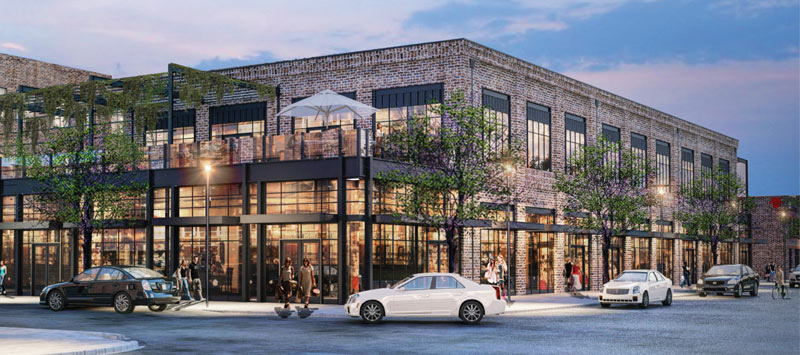
- 1818 Washington [Lovett Commercial]
- Previously on Swamplot: How To Polish Up the Dent in Silver St.;
Platypus and Friends Now Decorating Washington Ave Nesting Sites; Citywide Wave of Taco Colonization Will Continue with Occupation of Former Drake Nightclub in Sawyer Heights; Have Butchers Come to Carve Up Washington Ave’s Dittman Building?
Images: Lovett Commercial




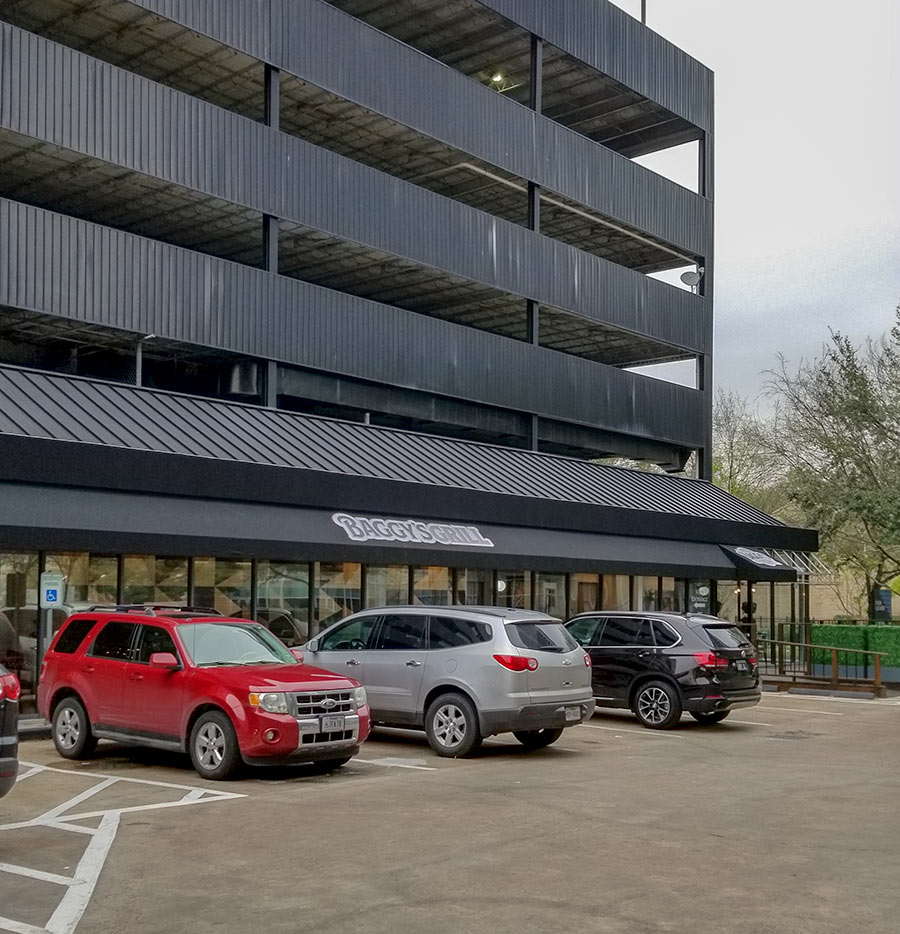
OK, these look great. And it fits in well with its neighbors on either side.
However, if you zoom out a little further, this is a tiny archipelago of street-facing buildings in a vast sea of surface parking lots. Here’s hoping they DO build that parking structure, then lease space in it to their neighbors, who could in turn convert their surface parking lots into better uses.
I can’t believe that with the dramatic increase in area flooding over the last decade, we are still paving huge acreage just for the hell of it. If you really think your three-unit development needs 542 parking spaces, why not at lease use a pervious surface? You know, think outside the box a little? The millennial clientele would probably think its was cool.
@Mike, just like the people in the Heights want their development more than anything else, anyone talking about flooding is going to.be continuously shushed… until they get flooded and wonder why a city government financed by developers did not protect them from development. You’re right, though. It’s so obvious that people need to to at least be using permeable concrete. If the ground is too hard, drill down past the clay and create a conduit to the water table. But hey, why bother? I’m sure this city will continue to grow and prosper and the taxes will still come pouring in years after after it exacerbates it’s reputation as a flooded out mess far behind the tipping point. It will make our elected leaders look so smart when the pension system fails anyway because energy companies choose to move to Austin, OKC, DFW and Denver because they can’t in good conscience relocate people to the flooded mess of our city. Oh wait, you say energy companies would never leave Houston? Remember, the oil companies fled New York decades ago. Recently BP has moved it’s onshore group to Denver. Exxon is gone to the Woodlands and lets not pretend that didn’t have anything to do with escaping the hot mess of city hall mismanagement.
Also, as companies that move west have selectively being annexed, other companies are learning that to be unaffected by the policies of the city, they have to go far far away. Let’s not be naive. This lesson is being learned.
ToF,
Now that additional impervious cover is taxed by the city, developers have an incentive to use permeable systems for parking lots. White Oak Music Hall is one example. Wouldn’t be surprised if this development did the same.
@Ang, three problems: First, the city grants exemptions for any new development that already had concrete on it. This does not prevent new developments from elevating their developments and worsening the flooding of their neighbors. Second, developers lie and claim entire plots of land are covered with concrete when they are not. Third, the city does not build adequate infrastructure with the money they do get so it doesn’t help to contribute to a flooding infrastructure fund that will just get raided for other purposes.
FYI Ch, 26, aka the parking ordinance, requires this number of spaces.
ToT,
This statement below is no longer true.
“First, the city grants exemptions for any new development that already had concrete on it. ”
Prior land use can no longer be used to exempt new development. A detention rate may be reduced, but it will not be eliminated. Impact fees will not be waived. Even with the reduced detention rate, it’ll be better than before.
The CoH, Harris County, and HCFCD no longer have the political will to approved items that appear to be lenient on the potential for increased flooding.
@Tired of flooding and
If developers could build with NO parking, they would – and it would be lucrative. Minimum parking requirements are set by the city of Houston, and they don’t vary. This means that a retail project downtown has the same parking requirement as a project in the Heights, Uptown, Gulfgate, Kingwood, and Alief. You can always ask for a variance, but you can’t count on it.
In this case, the developers wanted to build four small buildings to create a pedestrian scaled development less than a mile from downtown Houston. They determined that in order to meet the city of Houston’s minimum parking standards, the cheapest alternative was to buy an additional 4 ACRES of prime inner loop land at prime inner loop prices and pave it. Greedy developers don’t want to buy land that doesn’t generate income for them. It’s more of a reflection of our ham fisted city and state government never being able to do nuance well.
@Shmoo,
Mostly agree, but a couple of quibbles: First, the CBD is exempt from parking minimums.
Second, if the city were to eliminate parking minimums, developers would probably build LESS parking, but probably not ZERO. Their retail clients usually demand some amount of off-street parking. However, one of the side effects of CoH’s minimums is that each developments must have parking for its exclusive use, so parking spaces are often used inefficiently.
Third, at some point, the value of land dedicated to surface parking exceeds the cost of building structured parking. That number is around $100/sf, whereas this land is probably worth about half that.
Tired of Flooding,
I want Houston to be so dense that it makes Tokyo look like Kansas.